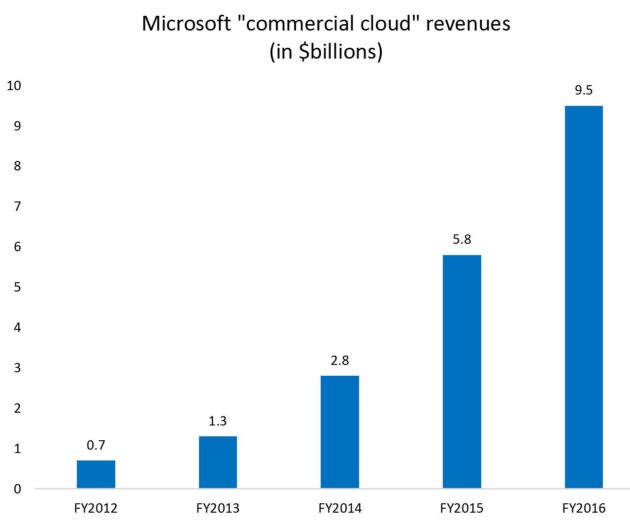Microsoft’s recent quarterly earnings report all but pointed to the company’s massive shift in focus towards its growing cloud businesses. Unfortunately, due to some rather creative reporting on Microsoft’s part, nailing down exactly how well the company has been doing at chasing industry leader Amazon while putting some distance between itself and other competitors such as Google or IBM has been a bit more difficult.
However, a new Microsoft regulatory filing may be our first glimpse into the success of Microsoft’s cloud businesses as well as an indicator or things to come for investors. The folks over at Geekwire were able to get their hands on a Microsoft regulatory filing that not only shows Azure and Office 365 up 40 percent from its previous year but that the two have helped the company reach close to $10 billion by the end of its fiscal year 2016.
As mentioned earlier, when Microsoft reports its numbers for the quarter, the company has recently begun to factor in run rates rather than pure profit. The way Microsoft calculates its new metric of run rate uses the most recent months’ revenue and multiplying that number by twelve to create an annual figure that can then be analyzed. The company’s new financial math has helped it report a commercial cloud run rate of roughly $12 billion in its last quarterly result.
However, when filing a regulatory 10-K report, Microsoft has to be a bit clearer on its numbers. Instead of the nice ballooned number of $12 billion-plus in revenue, the 10-K report shows a company that is closer to $9.5 billion. While seemingly not as impressive as its quarterly earnings report, it should be noted that following the previously reported 10-K reports Microsoft is on a clear trajectory upwards when it comes to cloud revenue.

Commercial Cloud revenue run rate
Microsoft’s Commercial Cloud, which includes Office 365, Azure and Azure-related services and products, has shown leaping growth year over year. Last year, Microsoft’s Commercial Cloud accounted to $5.8 billion in revenue, and only $2.8 billion in 2014 and the numbers go as low as a mere $700 million all the way back to 2012 reports.
Even with Microsoft reporting an almost $10 billion revenue run rate it’s still trailing far behind Amazon Web Services which reported $7.9 billion for its quarter. The reason for the glaring discrepancy in figures is how the two companies report their figures. Until recently, Amazon made similar use of bundled reporting of its cloud services but has since pulled AWS out and reported it strictly as a singular IaaS and PaaS, whereas Microsoft and Google combine Office 365 and other cloud-based Google Services into their reports. As it stands, AWS is a singular $7.9 revenue generating machine, while some obscured portion of Office 365 contributes to Microsoft’s $9.5 billion, lessening the potential amount Azure by itself brings collects.
However, as Microsoft’s revenue run rate continues its upward momentum, it shouldn’t be long before the company begins to break out Azure from Office 365 when Azure’s numbers can compete directly with AWS as the two cloud services race towards $10 billion mark.
[SOURCE:- WINBETA]




